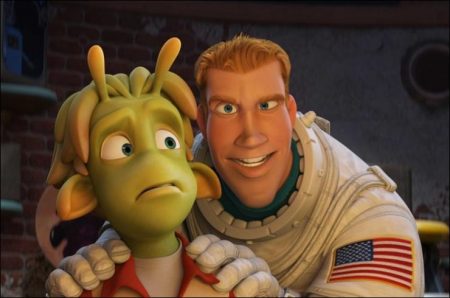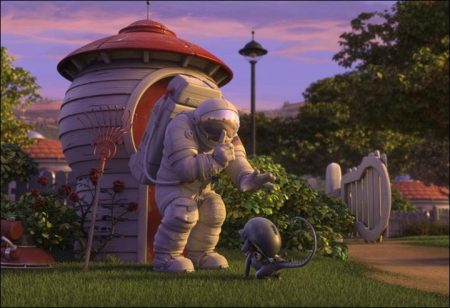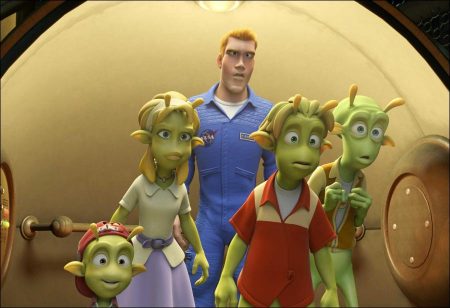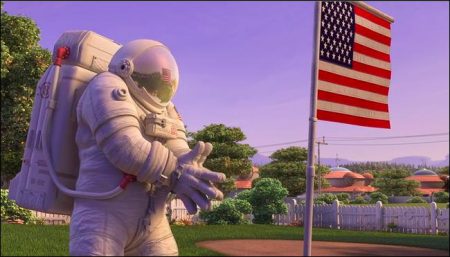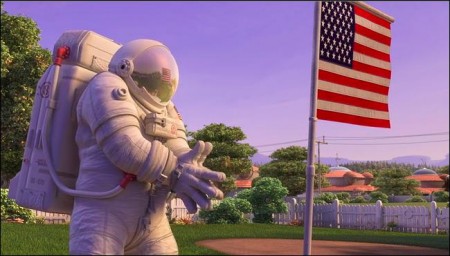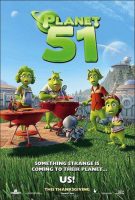Tagline: Something strange is coming to their planet… US!
Sixteen year old LEM lives on Planet 51, a white picket-fenced world reminiscent of a cheerfully innocent 1950’s America. He is happy in his safe, predictable world and spends his time daydreaming about running the local planetarium and dating the girl next door, NEERA.
One day out of the blue and millions of miles from his own planet, astronaut CAPTAIN CHARLES `CHUCK’ BAKER lands his spaceship in Neera’s backyard, right in the middle of a family barbecue! Unaware of his surroundings, he disembarks the ship reveling in his Big Moment. He plants his flag triumphantly and turns…only to find Planet 51’s green-skinned inhabitants staring back at him bemused! He panics and flees, finding refuge quite by chance in the planetarium where Lem works.
When Lem and Chuck meet, they gradually overcome their mutual fear and strike up a friendship. Lem agrees to hide Chuck from the paranoid Planet 51 Army who are determined to capture the alien within their midst, convinced he is out to destroy them. But all Chuck wants to do is reach his spacecraft before it returns to Earth without him! So with the help of Lem and his friends, a pair of not-so-bright Planet 51 soldiers, and an excitable but trusty explorer robot, ROVER, Chuck and the gang race to reach his spaceship before it is too lata…
About the Production
Ilion Animation Studios was launched in 2002 with the aim of becoming a leading animation studio creating computer generated full length animation feature films with global appeal. Such an ambitious project brought along with it huge challenges from a creative, technological and human standpoint; “we needed a great storyline, leading edge, in-house technology and a talented team of professionals to push the project forward. This was no mean feat. From the start we began looking for a fresh and original storyline that was highly differentiated from other movies”, says Perez Dolset. It was at this point that we decided to embark on a journey through our own hopes, dreams and fantasies.
Just like many others before us, we searched hard and fast through all the common themes, as well as some of the more unusual ones. We looked at universal themes with less original ideas which we felt were never really told well, or big storylines with universal appeal that we felt maybe deserved to be told again. And, as usually happens in these circumstances, just as we were coming to the conclusion that it had all been done before, we found Planet 51, or was it that Planet 51 found us, appearing from that place where great ideas lie in wait for their creators? At that moment we knew that this was Our Story.
After the first phase of development we searched for a world class scriptwriter to tell our story and we found one of the best in the business; Joe Stillman. He maintains it was love at first sight! From that first meeting, after we had presented the project to Joe, he packed his suitcases and went off to live on Planet 51. I believe he took up residence at a place opposite where Lem lives, or was it actually in Lem’s attic? Wherever he ended up staying, what was true was that he had created an extraordinary storyline packed with fantastic characters, bundles of humour, surprises, emotion and excitement.
“When I saw a 3 minute scene that showed an astronaut landing in the backyard of an alien suburban family, it completely knocked me out” says Stillman. The scene of the astronaut landing was really inspiring. It showed so much: the world of Planet 51, the sense of people in it, an understated acting style, a sense of visual motif, color palate, a really terrific sense of place and an advanced technical ability. And then there’s the stuff you can’t really quantify, which probably is best described as sensibility.
Jorge Blanco, Planet 51 Director point out that “our aim was always to tell a great story within an original context, to move away from the repetitive themes seen in many recent animated features”. We knew it wasn’t going to be easy and after exploring a long list of different ideas we came up with Planet 51: alien beings – little green men with antennae on top of their heads – living in fear of human invasion. The classic tale of an alien invasion but seen from a completely different angle!
This original idea opened up a whole world of possibilities and straight away we began to place our alien planet in its equivalent of 1950’s America. That fitted perfectly; in the 1950’s science fiction was king of the drive-in movies and on-screen heroes fought invaders from outer-space. These movies also provided the perfect melting pot for comedy and caricature; aliens wearing a toupee driving a Cadillac shaped like a flying saucer or invading `spaceships’ dangling from strings! We knew that all of these icons could work perfectly in our film.
In the same way that 1950s America inspired us to build Planet 51; it also gave us the opportunity to tap into the social paranoia towards sabotage or invasion which was increasing around that time. These were times when people’s mistrust lead them to believe that their neighbor could easily be an undercover agent trying to blow up the local bakery! In a similar way the inhabitants of Planet 51 regard an innocent astronaut with terror and mistrust, fuelled by fear and ignorance. These themes of conflict between different cultures fear of the unknown or anything that’s different run throughout the film.
Conscious of the huge challenge facing us with Planet 51’s character animation, we decided we would design our own computer animation tools and software, says Planet 51 co-director Javier Abad. Over the last six years, the team behind the characters and background sets have continuously developed these tools and placed Ilion Studios amongst the top ranked character animation studios in the world.
Developing the dramatic elements of each character is hugely important for the animators. They record each other time and time again until they come up with just the right performance that will help them to develop the best animation for the frame. It is incredible to see the sheer effort that each of the animators puts into their work so that the audience can truly feel all the emotions being portrayed in the movie.
All of us have seen movies featuring beings from other worlds; green, brown, with scales, without scales, monsters with huge heads or simply giants. Designing the inhabitants of Planet 51 involved taking these different references and blending them together. We wanted them to be fun, appealing and realistic without appearing too similar to us, but at the same time not looking like a monster either.
We also had to imagine an entire world, says co-director Marcos Martinez: the clothing, the doorways, the cars, the streets, the city, the mountains, the animals. Planet 51 is world of happiness, and a world of innocence, where people don’t even consider what might be out there beyond the heavens, because in their world everyone is as happy as they’ll ever be. However this idyll is disrupted when something strange arrives on the planet. Something that will change their lives forever. Something from beyond the stars… A being from another planet.
Planet 51 is much more than a planet inhabited by green colored beings with antennas. Do they eat hotdogs? Do they go ten-pin bowling? What music do they listen to? In the cinema a spectator eats popcorn that floats and drinks a satellite soda… On the street a traffic sign warns the flying saucer vehicles not to float too high. The city is so full of life that it doesn’t all fit into one film! However the attentive spectator will realize that in each poster, each billboard and shop front, there is a window that opens up to a world as large as our own.
Who hasn’t seen a poster for an alien movie? Old and new films about nasty invaders from outer space with green skin. What if the posters came from an alien planet featuring human beings as the invaders?! How would they market their films? Planet 51 is full of funny twists, both for the young, the old and for the nostalgic…
The movie shows a planets going through its own 1950’s, with a sci-fi invasion movies and a healthy dose of paranoia atmosphere. “The main difference between their world and ours is that by the end of our 1950’s, we were looking towards the stars, to the great unknown and the beginning of our age of space exploration”, says Stillman. But the people of Planet 51 are missing that thirst for knowledge. They’re afraid of the unknown. And so their innocent 1950’s period is one that just goes on and on. What changes all that, what opens our main character to the greater universe, is the arrival of astronaut Chuck Baker. In this sense, Lem embodies everything about Planet 51 and the theme of the movie. He’s afraid of the unknown. As it happens, I am too, Stillman says. When a character gets to grow in a way that’s resonant for me, as Lem does, he becomes kind of special.
Planet 51 Characters
LEM is a model kid. He never misses a class, is never late, and has certainly never been called to the principal’s office. Kind of cute for someone with green skin but also a bit geeky, he always does the right thing. However, little by little, and with the help of Chuck, Lem learns that there is more to life than following the rules, especially if you’re going to have to save the planet!
Age: 16
Occupation: High school junior by day, Junior Assistant
Planetarium Curator by night
Mission: To date his childhood sweetheart, Neera
Likes: Gazing at the stars
Dislikes: Anything out of the ordinary
CHUCK BAKER is not your average astronaut. On the outside he walks the walk. His appearance, smile and charm have made him the eternal Casanova, a hero of millions, and gotten him voted as the 37th sexiest guy on planet Earth. He has traveled across millions of miles to plant a flag on a planet…which is already inhabited! Chuck will do everything he can to prove to himself that he has The Right Stuff!
Age: Mid-30’s
Occupation Astronaut
Mission: To boldly go where no man has gone before
Likes: The ladies, making headlines
Dislikes: Space food
SKIFF, Lem’s best friend, is quirky and paranoid, always thinking that the government is telling lies and hiding the truth that aliens really do exist. He is desperate for someone that understands and loves him, and when he finally meets Rover he finds a true friend.
Age: 16
Occupation: High School Junior/Conspiracy Theorist Extraordinaire
Mission: To find `Base 9′ where he is sure the government is hiding aliens
Likes: Bowling and his new best friend, Rover
Dislikes: Aliens!
NEERA is pretty with a strong personality. She doesn’t like to be told what to do, especially when it comes to who she should hang around with. She is a bit lost between her desire to be a rebel and her feelings for Lem, but will learn that virtue and bravery, as always, are tucked away in the heart, just waiting to be discovered.
Age: 16
Occupation: High School Junior/ Wannabe hippie
Mission: To make her planet a better world
Likes: To be surprised
Dislikes: Following the rules
GENERAL GRAWL, Strong, willful and intimidating, is the most powerful person on Planet 51. As commander of the Army it is his mission to protect his planet from alien invasion. He is prepared to fight to the end, but is he prepared to meet Chuck?!
Age: 43
Occupation: Military Commander
Mission: To protect Planet 51 from any possible alien invasion
Likes: Order, discipline, control
Dislikes: Aliens, Alien collaborators, and last but not least… hippies!
PROFESSOR KIPPLE, Bald, brilliant and impressive, but only half the size of a normal inhabitant, is the Einstein of Planet 51, an intellectual superstar, and the proud owner of the biggest brain on Planet 51. When the “alien” arrives Kipple insists it be taken alive so it can be studied. But he has a secret mission: to own the two biggest brains on the planet…the “alien’s” and his own!
Age: 60
Occupation: Planet 51’s resident genius
Mission: To collect the biggest brains.
Likes: Brains, creating mass hysteria
Dislikes: Beings of lesser intellect (everyone!)
ECKLE: To be a boy who likes comics, sci-fi films, monsters and aliens, is not an odd thing on Planet 51, but when you are as fascinated by it as 6 year old is, you can drive your parents mad! So don’t be surprised to see Eckle’s mother dragging him out of the newest Humaniacs movie by his antennae!
Age: 7
Occupation: Sci-fi fan
Mission: To get an alien’s autograph
Likes: Humaniacs I, Humaniacs II
Dislikes: Paying attention to anything other than sci-fi, aliens or monsters
ROVER was built for roaming rough intergalactic terrain and his mission is to explore alien planets, collect samples and send images back home. A loveable robot,that likes nothing more than being tickled and once you’ve earned his trust you’ll have a friend for life.
Age: Assembled in 2009
Occupation: Space exploration robot
Mission: To collect samples
Likes: Rocks (A lot!), Skiff
Dislikes: Vermin under rocks
Creating a New World
Planetization!
Three basic patterns constitute the core of Planet 51’s visual style: Circles, spheres and saucers: a template that was specifically designed to adapt all shapes and forms familiar to us to a more alien -yet recognizable- style, providing overall consistency and credibility.
Two of these patterns were extracted from classic icons of Sci-Fi pop culture and mythology – flying saucers and crop circles – while the third was derived from Googie Architecture, a futurist design style born of the post-WWII car-culture and thrived in the 1950s and 1960s and which was also highly influenced by the Space and Atomic Ages. The futuristic designs that typified Googie Architecture inspired the notably retro look of Glipforg. Thus a term was unofficially coined whenever facing the design of any new prop and having to adapt it to Planet 51’s circular and rounded aesthetics… `let’s Planetize that telephone!’
This retro sci-fi vibe was reinforced when conceptualizing the landscape of the town: the idea was to have flying saucers on top of the city, and consequently, roofs were shaped like flying saucers so that when looking from above you would get the impression of an invasion.
Conceptualizing the `Planetization’ of all visual elements was one thing, but implementing it was an entirely different story, constituting a most formidable feat that struck at the heart of production, according to Sets & Props Supervisor Fernando Huelamo: “The greatest challenge that we faced was creating circular objects in 3D – very, very difficult. 3D objects are by definition essentially cubes!” But the fact that it was a challenge didn’t make it any less enjoyable.
“It was a lot of fun to redesign all these things.” says co-director Marcos Martinez, “If I was an alien and everything in my world was round, how would I design a chair, a telephone, or a gun? When we think of aliens: they have ray-guns, they have flying saucers – let’s filter it through our world’s design. This is a very rich world where nothing is spared that design.”
Another crucial if not immediately noticeable quirk that has become a landmark of `planetization’ and that affects almost all props in Planet 51 is an extraneous circular area in one corner that renders the object asymmetric. According to Art Supervisor Fernando Juarez: “It was simply to provide a small but pointed difference to Earth Signs. If it was perfectly round, then it would be the same.” And if it were the same, that would defeat the purpose of creating a different world.
As can be expected in a world designed by sci-fi lovers, even food, which floats and glows, does so paying homage to another sci-fi movie from the 80’s, Coccoon: “In that particular film, the aliens have an inner energy, immediately indicating they are more advanced. So, I thought that all the food would have this element too and it would make it glow!” Juarez says.
One curious thing to note, is that while all Planet 51’s military weapons strongly resemble the typical 50’s B-movie alien ray guns, they don’t actually behave as ray guns, but as bullet-based earth weapons. “In all the 50’s movies where the military are persecuting the aliens,” notes Fernando Huelamo, “these kinds of weapons are the most prevalent, so you have to keep that in mind. We didn’t want to have it appear different from those films”. So, on the one hand we have regular guns and rifles like the ones we have on Earth, and on the other hand, they are `planetized’ in such a way that they remind us of the typical alien ray guns.
Landscaping a Planet
If Planet 51 is indeed based on the America of the 1950’s, then it might be easy to picture Glipforg as an alternate Southern California. “Yes, that’s one notion,” asserts Art Supervisor Fernando Juarez, but for the landscapes surrounding Glipforg, “The Grand Canyon and Colorado” were clear inspirations, he adds. “Our references were not just fifties movies, but the reality itself – it had to be very recognisable.”
Glipforg was anchored in what co-director Marcos Martinez labels “a very classical vision of 50’s America, even if it’s not real – it’s the collective image we have of those years. We can see that image of America in a great many things and that’s what we wanted to put in to the film. We looked at all the films that possessed that vision.”
Where to Hang Around When Visiting Glipforg?
Observatory
Of all the various locations in Glipforg, this is the one which draws more clearly from a specific real-world reference: “Everything in the movie has a reference and this particular location came quicker that we anticipated because of The Griffith Observatory, which features these big windows.” Says Visual Production Designer Julian Romero. The world-famous Griffith Observatory in Los Angeles built in 1935, with its distinctive Art Deco Style made it the perfect choice for inspiration.
Comic Book Store
With a 3-D Humaniac reaching malevolently over entering customers and its insanely detailed interior, Haglog’s Comics might very well be the single, most unique and design-rich location in Glipforg. The entire place reeks of 50’s Sci-Fi B-Movies, and embodies the very essence of Planet 51. “Everything you can imagine about Planet 51 is in that shop. It’s a world inside a world. We put such an effort in to it that it feels that the entirety of the Planet 51’s tone is essentially condensed into that one location, via the posters and the books, the small toys, tables, lamps etc.”
Places to go with your friends
HUMANIACS II is the film within the film, (and a huge event in itself) it opens the movie and introduces us to Planet 51’s inhabitants deepest rooted fear: to be invaded by us -sort of-. All this takes place inside Glipforg’s cinema, where the retro stylings and Art Deco motifs accompany an oval-shaped screen. Once we move outside, we have the chance of admiring the building itself, with its saucer shape and teeming with spires and antennae, possessing a massive central dome over the main auditorium and a Space Age radio mast perched atop the main entrance.
If however, you feel more interested in some action, you can always check out the Bowling Alley. If there is a building closest to resembling a full UFO mothership, this will be it. The interiors are splendidly garish, from the chequered floors to the bowling balls that are shaped like ringed planets.
The Picket Fenced Nirvana
The clearest expression of the myth of the white-picket fenced nirvana of 1950’s America rests serenely in the outskirts of Glipforg, where you’ll find the residential area. Much like the rest of the town, the residential area is defined by streets of concentric circles filled with saucer-shaped buildings. Here, the impending invasion theme is also present, “ The recurring aerial image of flying saucers flying over the rooftops of a city,” explains Visual Production Designer Julian Romero, “serves as a constant reminder of an invasion.” and even more so strengthened since in the residential areas this reminder would clash effectively with the overall sense of being secure.
Mid-Town Area
“We never lost the vision that someone watching the film wouldn’t recognize what they are looking at. Even though it was a saucer shape, you could easily identify a building and the type of building it was.” explains director Jorge Blanco, and it becomes apparent when you view the sheer diversity of buildings that, while keeping the same flying saucer motif, adopt very unique and distinctive shapes and forms, which make them all individually recognizable. At Main Street, you can catch glimpses of Glipforg’s largest municipal buildings, one of which would be the White House-inspired Town Hall, complete with white stone and pillars, but of course, having a roof composed of three flying saucers, one larger flanked by two smaller ones.
Glipforg’s High School is not any less magnificent, also reminiscent of a huge mothership due to its sheer size, but less accented in its Flying Saucer shape than the Bowling Alley, so one could almost picture this building existing in our world. Right outside the High Shool and in front of the entrance stands a statue of Glipforg’s founder Pacifier Glipp (intended to be a sly wink at Isaac Newton).
It’s the Gas Station that features the most original application of the saucer motif: the saucer constitutes the overhead cover of the station’s forecourt, an area lit by fluorescent lighting located on the underside of the saucer section. There is a slight difference with the rest of saucer motifs found in the rest of the buildings, though: here, the saucer section looks as if it had been directly plucked from a 50’s B-Movie!
One exception to the general design rule would seem to be the Hot Dog restaurant, the only building in Glipforg not to feature a saucer-like theme, but instead a giant U-shaped hotdog. Even if this might fit within the Googie category, could it be a design oversight? Not at all, confirms Visual Production designer Julian Romero, for it’s in fact Planet 51’s most difficult to get homage: “There is one very obscure film reference in that the giant curved hot dog is in fact the crashed ship in Alien.”
How to Move Around in Planet 51
It’s quite easy to single out one of the aspects of Planet 51 that most stands out in the eyes of everyone. “Our turning point was the saucer-shaped 50’s cars and that informed the entire twist of PLANET 51.”
Says director Jorge Blanco. The moment the suggestion arose of a Cadillac shaped like a flying saucer, it was as if someone had set off a fuse…the film gained a considerable boost that served as catalyst for all design-related decisions. More so, according to co-director Marcos Martinez it was an aesthetic choice that was a dream to design: “The easiest thing to design was the cars. We had that idea from the very beginning and that was one of the best things to work on.”
The opportunities seemed endless, there were so many recognizable brands/models out there which still retained their identity after being `planetized’, and they all fitted flawlessly in to the film’s vision of the 50’s America. The fact that so many disparate and distinct vehicle designs – from municipal vehicles like the police cars, school and public buses, taxis, fire trucks et al to familiar, classic period car designs – are converted in to the rotund and bubble-like shape of alien craft so successfully amply shows off the sheer malleability of the concept. Likewise for the military vehicles, which convert Sherman tanks, jeeps, trucks and, memorably, a spider-legged crane with seeming effortless ease. One thing about these vehicles, of course, is that they don’t move on wheels; they hover!
“All the cars are references to actual cars of that period.” Martinez adds, noting that the various vehicles have been at the forefront of people’s appreciation of the film’s look. “I’ve known people who have looked at the film who have been amazed at what they have seen. They recognize all the vehicles in the movie.”
The film’s producer, Ignacio Perez Dolset comments: “The element of Cars that are flying saucers is the one that we are most proud of in this production. It is what we enjoyed creating the most and it’s one step beyond what we have seen before.”
Technical Production Notes
To withstand the rigors of production, Ilion Animation Studios must have a well developed technical infrastructure, as such the initial ideas of using ‘white box’ workstations and assembling a render farm from computer parts, were quickly discarded. With the aid of over 200 Hewlett Packard workstations and HP network infrastructure, over 56,000 GB of BluArc storage space and over 2500 , Blade and 1U, render cores, Ilion’s artists are now delivering a world class product.
Ilion Animation Studios knew that making a movie such as Planet 51 was going to be a huge challenge in and of itself, so from the start they planned to avoid the common technical pitfalls of computer graphics: global illumination, hair, cloth simulation and subsurface scattering. As production progressed, it was clear that the elements they had been avoiding would be necessary in order to deliver a film of the quality desired, “It was our need to excel, that drove us to take on the challenges and add those special details that make Planet 51 the film it is today.” says Ilion Director of Technology Gonzalo Rueda.
Originally, the Astronaut, Chuck, didn’t take off his helmet during the entire movie. “I remember the day that someone said that it was essential for us to see the astronaut’s face and facial expressions in order to better connect with the character.” says Rueda, “We all knew it was going to be a huge technological hurdle to insert hair into our aesthetic, especially considering global illumination, subsurface scattering and all the other details that now define the Planet 51 look. But we started on the problem immediately, eventually overcoming the challenges and finally achieving the amazing look we have today. ”
Ilion Animation Studios has managed to produce a product on par with the world’s top animation studios, at a significantly lower budget. “Our focus on having a strict and automated pipeline and the emphasis on controlling access to IT resources at a studio level, have been key in allowing us to produce a film of the quality of Planet 51 within our budget.”
Ilion Animation Studios has had to overcome many barriers on the way to making it’s first feature film, Planet 51. Rueda says, “Our insatiable desire as a studio to make the best movie we could possibly make, has meant that new ideas on how to improve the film were implemented regardless of the plethora of technological challenges they may present. It has been through the talent, motivation and joint efforts of our artistic and technical teams that we have managed to make all the things we dreamed a reality, by getting them into our pipeline and ultimately on-screen. During the development of Planet 51 we managed to solve so many issues that we previously did not know how to, that I’m certain we can achieve anything we set our minds to. It’s exciting to think that this is only our first film, and that over the past seven years we have gained the knowledge, and confidence, to take Ilion Animation Studio into the future.
Planet 51 (2009)
Directed by: Jorge Blanco, Javier Abad, Marcos Martinez
Starring: Dwayne Johnson, Jessica Biel, Justin Long, Seann William Scott, Gary Oldman, John Cleese, James Corden, Lewis Macleod, Rebecca Front, Rupert Degas, Alan Marriott
Screenplay by: Joe Stillman
Production Design by: Julian Muñoz Romero
Film Editing by: Alex Rodríguez
Art Direction by: Fernando Juárez
Music by: James Seymour Brett
MPAA Rating: PG for mild sci-fi action and some suggestive humor.
Distributed by: Sony TriStar Pictures
Release: November 20, 2009
Views: 199
